FME Transformers: 2025.2
Resamples rasters to multiple resolutions, based on either number of levels or dimensions of the smallest output raster.
Typical Uses
- Preparing rasters for viewing at multiple zoom levels when tiling is not required, or if tiling has already been done.
How does it work?
The RasterPyramider accepts raster features, and “pyramids” them - resampling them to produce a set of output rasters at varying resolutions, appropriate for different zoom levels.
The number of rasters produced may be specified by Number of Levels, or by defining the smallest level size by number of columns and rows in cells (pixels).
Various methods are available for interpolation of pixel values during resampling.
Attributes may be added to the output tiles to record Pyramid level, original raster index, and number of levels produced.
This transformer is unaffected by raster band and/or palette selection.
Examples
In this example, we will create pyramids for an orthophoto. The source image is 1 meter resolution, at 1600 by 1000 pixels. Note the Min and Max Extents - these will remain unchanged as the image is resampled.
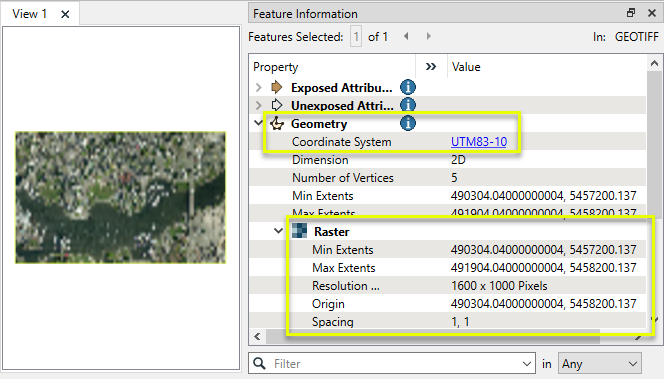
The raster is routed into a RasterPyramider.

In the parameters dialog, we select Number of Levels as the method, and set that number to 4.
Force Level Sizes to be Powers of Two is set to Yes - this will force raster dimensions to the commonly-used progression of powers of two - see Parameters below for more details on how this works.
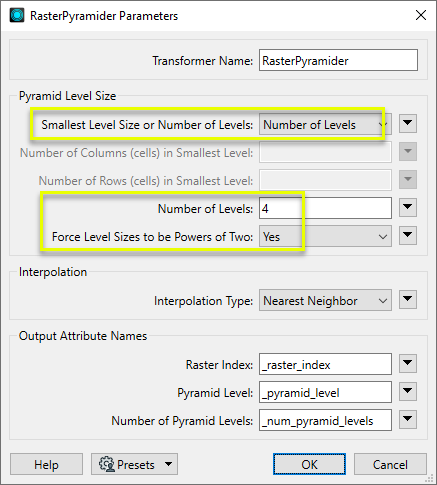
Five raster features are output - the original, which is Level 0, plus four new pyramided rasters.
Pyramid Level 1
Pyramid Level 1 is the closest to the original raster, with new dimensions, 1024 by 512, according to the Powers of Two parameter.
Note that the geographic extents are the same as the original - but the pixel size (spacing) and resolution have changed.
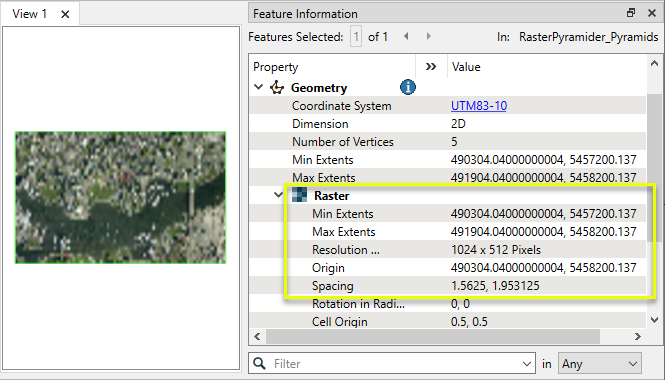
Pyramid Level 4
At Pyramid Level 4, the geographic extents are still the same but the raster itself is much smaller at 128 by 64 pixels.
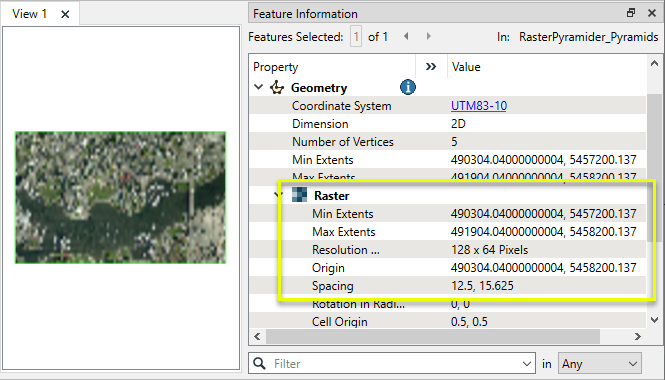
A closer look at the bridge detail clearly illustrates the results of resampling for different levels.
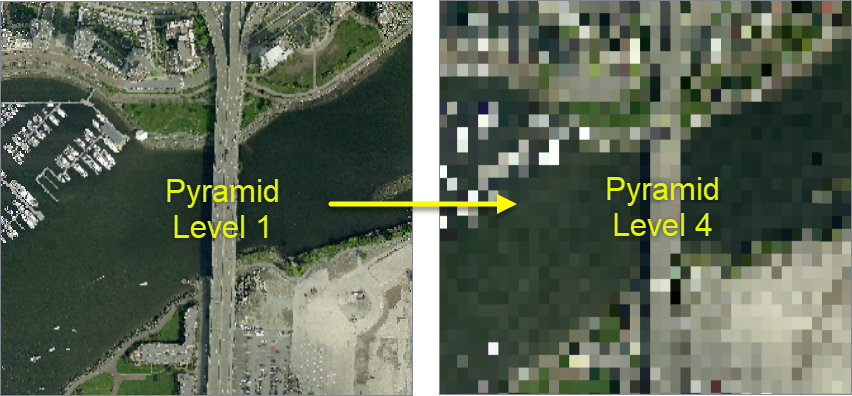
Note on Powers of Two
Using the Powers of Two parameter will produce raster dimensions with common and useful numbers for display purposes. However, if the source raster’s dimensions are not originally a power of two, as may often be the case, pyramiding using powers of two will produce pixels that are not square in ground units.
In this example, the source image pixels are 1 meter square (Spacing 1,1). At pyramid level 1, the spacing (pixel size in ground units) becomes 1.5625, 1.93125. The difference in the width and height of the pixel is a result of finding the nearest power of two numbers to scale vertically and horizontally - that is, interpolating 1600 x 1000 to 1024 by 512 within the same geographic extents.
Usage Notes
- To tile and resample rasters using zoom levels and positions defined for various web mapping tile schemes, consider using the WebMapTiler.
Choosing a Raster Transformer
FME has an extensive selection of transformers for working with raster data. They can be generally categorized as working with whole rasters, bands, cells or palettes, and those designed for workflow control or combining raster with vector data.
For information on raster geometry and properties, see Rasters (IFMERaster).
Working with Rasters
|
Sets the cell origin point within cells in a raster. |
|
|
Applies a convolution filter (sometimes called a kernel or lens) to raster features and outputs the results. |
|
|
Enhances the features of a raster image. The RasterDiffuser enhances the borders, lines, and curves while reducing noise in the flat areas of the raster image. |
|
|
Evaluates expressions on each cell in a raster or pair of rasters, including algebraic operations and conditional statements. |
|
|
Replaces the geometry of input raster features with a polygon covering either the extents of a raster or the extent of data within a raster. |
|
|
Extracts Ground Control Point (GCP) coordinate system and point values from a raster feature and exposes them as attributes. |
|
|
Sets Ground Control Points (GCPs) on a raster, pairing cell positions with known coordinates. |
|
|
Georeferences a raster by either known corner coordinates or origin, cell size, and rotation. |
|
|
Generates a grayscale shaded relief representation of terrain, based on elevation values. |
|
|
Alters the interpretation type of rasters, including all bands, and converts cell values if necessary. |
|
|
Merges multiple raster features into a single raster feature. |
|
|
Extracts the geometry properties of a raster feature and exposes them as attributes. |
|
|
Resamples rasters to multiple resolutions, based on either number of levels or dimensions of the smallest output raster. |
|
|
Transforms an image to minimize its difference with another. |
|
|
Resamples rasters, based on specified output dimensions, cell size in ground units, or percentage of original, and interpolates new cell values. |
|
|
Rotates a raster feature according to its rotation angle property, interpolating new cell values, updating all other affected raster properties, and producing an output raster feature with a rotation angle of zero. |
|
|
Clips raster features using pixel bounds instead of ground coordinates, and optionally adds cells around the perimeter. |
|
|
Splits each input raster into a series of tiles by specifying either a tile size in cells/pixels or the number of tiles. |
|
|
Creates polygons from input raster features. One polygon is output for each contiguous area of pixels with the same value in the input raster. |
|
|
Creates a series of image tiles that can be utilized by web mapping applications such as Bing™ Maps, Google Maps™, or Web Map Tile Service. This is done by resampling rasters to various different resolutions and then splitting them into tiles. |
Working with Bands
|
Adds a new band to a raster feature. |
|
|
Merges coincidental raster features into a single output raster feature, preserving and appending all bands. |
|
|
Alters the interpretation type of individual raster bands, converting cell values if necessary. |
|
|
Removes all unselected bands from a raster feature. |
|
|
Extracts the minimum and maximum band values, palette keys, and palette values from a raster feature, and adds them to a list attribute. |
|
|
Sets the band name of selected bands on a raster, making raster contents simpler to understand compared to band numbers. |
|
|
Removes the existing Nodata identifier from selected bands of a raster feature. Any values previously equal to the Nodata value are considered valid data. |
|
|
Sets a new Nodata value on selected bands of a raster feature. |
|
|
Specifies the required order of bands in a raster. Bands are reordered according to the input band indices. |
|
|
Extracts the band and palette properties of a raster feature and exposes them as attributes. |
|
|
Removes any selected bands from a raster feature. |
|
|
Separates bands or unique band and palette combinations, and outputs either individual raster features or a single new raster feature containing all combinations. |
|
|
Calculates statistics on raster bands and adds the results as attributes. |
Working with Cells
|
Calculates the aspect (direction of slope) for each cell of a raster. Aspect is measured in degrees from 0 to 360, clockwise from north. |
|
|
Creates individual points or polygons for each cell in a raster, optionally extracting band values as z coordinates or attributes. |
|
|
Evaluates basic arithmetic , minimum, maximum or average operations on the cell values of a pair of rasters. |
|
|
Replaces a range of band values in a raster with a new single value. |
|
|
Rounds off raster cell values. |
|
|
Partitions a raster image into arbitrarily sized groups of cells from the input image based on intensity differences in the input raster image cells. |
|
|
Performs basic arithmetic operations on the cell values of a raster against a numeric value. |
|
|
Calculates the slope (maximum rate of change in z) for each cell of a raster. |
Working with Palettes
|
Creates a palette from an attribute, and adds this palette to all selected bands on a raster. |
|
|
Creates a string representation of an existing palette on a raster and saves it to an attribute. |
|
|
Generates a palette out of the selected band(s) of a raster. The output raster will have the selected band(s) replaced by a new band with a palette. |
|
|
Alters the interpretation type of raster palettes. |
|
|
Identifies the palette key that matches a raster band’s Nodata value, and sets a value on it. |
|
|
Removes selected palette(s) from raster features. |
|
|
Resolves the palette(s) on a raster by replacing cell values with their corresponding palette values. Palette values with multiple components, such as RGB, are broken down and the individual values assigned to multiple, newly-added bands. |
Workflow Control
|
Forces accumulated raster operations to be processed, saving the state to disk and releasing resources to tune performance or assist with memory limitations. |
|
|
Reads raster features for testing purposes, including any accumulated raster operations. No additional operations are performed, and nothing is done with the features. |
|
|
Serializes the geometry of a raster feature into a Blob attribute, encoding the contents according to a choice of common binary raster formats. |
|
|
Creates a numeric raster of specified size and resolution, with default cell values. |
|
|
Decodes a binary attribute containing encoded rasters stored as Blobs, replacing the feature’s geometry with the decoded raster. |
|
|
Creates a color raster feature of specified size, resolution, and interpretation type, with default cell values. |
|
|
Selects specific bands and palettes of a raster for subsequent transformer operations. |
Vectors and Rasters
|
Creates a raster representation of vector or point cloud input features, using the fme_color attribute over a solid background fill for vector features. Point clouds may be rendered using their color or intensity components. |
|
|
Creates a numeric raster representation of vector or point cloud input features, where cell values are taken from the z coordinates of the input features and overlaid on a uniform background. |
|
|
Generates a raster from input vector and raster features, with fine control over symbolization and labeling, using the Mapnik toolkit. |
|
|
Sets point cloud component values by overlaying a point cloud on a raster. The component values for each point are interpolated from band values at the point location. |
|
|
Extracts the band and palette values from a raster at the location of one or more input points and sets them as attributes on the feature. |
|
|
Produces a raster digital elevation model (DEM) by uniformly sampling a Delaunay triangulation generated from input points and breaklines. |
|
|
Rasterizes vector or point cloud features onto an existing raster. For vector features the fme_color attribute sets pixel color, and point clouds may be rendered using their color or intensity components. |
Configuration
Input Ports
This transformer accepts only raster features.
Output Ports
Original raster features and resampled (pyramided) rasters according to the parameter selections.
Non-raster features will be routed to the <Rejected> port, as well as invalid rasters.
Rejected features will have an fme_rejection_code attribute with one of the following values:
INVALID_GEOMETRY_TYPE
INVALID_GEOMETRY_NO_BANDS_IN_RASTER
Rejected Feature Handling: can be set to either terminate the translation or continue running when it encounters a rejected feature. This setting is available both as a default FME option and as a workspace parameter.
Parameters
|
Smallest Level Size or Number of Levels |
Choose a method for creating pyramids: Smallest Level Size: Specify the smallest desired pyramid dimensions and calculate appropriate interim level sizes and number of levels. Number of Levels: Specify the number of levels desired, and calculate interim sizes. |
|
Number of Columns (cells) in the Smallest Level |
When Smallest Level Size is selected, the smallest pyramid level will have a specified size, in cells (pixels). This is not the geographic extent. Define the number of cells (pixels) for the width of the smallest (lowest resolution) pyramid raster. Each subsequent level will increase the number of rows and columns by a factor of two, until the size of the input raster is reached. |
|
Number of Rows (cells) in the Smallest Level |
When Smallest Level Size is selected, the smallest pyramid level will have a specified size, in cells (pixels). This is not the geographic extent. Define the number of cells (pixels) for the height of the smallest (lowest resolution) pyramid raster. Each subsequent level will increase the number of rows and columns by a factor of two, until the size of the input raster is reached. |
|
Number of Levels |
If the Number of Levels is specified, then the largest pyramid level generated will have half the number of rows and columns of the input raster. Each subsequent level will decrease the number of rows and columns by a factor of two, until the specified number of levels has been generated. |
|
If Yes, the number of rows and columns in all generated levels will be powers of 2. When Smallest Level Size is specified, the number of rows and columns in the smallest level will actually be the smallest powers of 2 that are greater than or equal to the specified values. When Number of Levels is specified, the number of rows and columns in the largest pyramid level will be the greatest powers of 2 that are less than or equal to the number in the input raster. Note that pyramid levels will not be generated if either the number of rows or the number of columns is less than 2. |
|
Interpolation Type |
Cell values are interpolated in order to change the raster to the specified sizes.
|
|
Raster Index |
If a Raster Index Attribute is specified, an attribute will be added to each output feature that identifies which raster it was created from. This index is zero-based, so all pyramid levels created from the first input raster will have a value of 0, all pyramid levels created from the second input raster will have a value of 1, and so on. |
|
Pyramid Level |
If a Pyramid Level Attribute is specified, an attribute will be added to each output feature that identifies its level in the pyramid. The input raster is considered to be the base of the pyramid (level 0), so the largest level that is output for a given input raster will have a value of 1, the second largest will have a value of 2, and so on. |
|
Number of Pyramid Levels |
If a Number of Pyramid Levels Attribute is specified, an attribute will be added to each output raster indicating the number of levels in the pyramid to which it belongs |
Editing Transformer Parameters
Transformer parameters can be set by directly entering values, using expressions, or referencing other elements in the workspace such as attribute values or user parameters. Various editors and context menus are available to assist. To see what is available, click  beside the applicable parameter.
beside the applicable parameter.
Defining Values
There are several ways to define a value for use in a Transformer. The simplest is to simply type in a value or string, which can include functions of various types such as attribute references, math and string functions, and workspace parameters.
Using the Text Editor
The Text Editor provides a convenient way to construct text strings (including regular expressions) from various data sources, such as attributes, parameters, and constants, where the result is used directly inside a parameter.
Using the Arithmetic Editor
The Arithmetic Editor provides a convenient way to construct math expressions from various data sources, such as attributes, parameters, and feature functions, where the result is used directly inside a parameter.
Conditional Values
Set values depending on one or more test conditions that either pass or fail.
Parameter Condition Definition Dialog
Content
Expressions and strings can include a number of functions, characters, parameters, and more.
When setting values - whether entered directly in a parameter or constructed using one of the editors - strings and expressions containing String, Math, Date/Time or FME Feature Functions will have those functions evaluated. Therefore, the names of these functions (in the form @<function_name>) should not be used as literal string values.
| These functions manipulate and format strings. | |
|
Special Characters |
A set of control characters is available in the Text Editor. |
| Math functions are available in both editors. | |
| Date/Time Functions | Date and time functions are available in the Text Editor. |
| These operators are available in the Arithmetic Editor. | |
| These return primarily feature-specific values. | |
| FME and workspace-specific parameters may be used. | |
| Creating and Modifying User Parameters | Create your own editable parameters. |
Table Tools
Transformers with table-style parameters have additional tools for populating and manipulating values.
|
Row Reordering
|
Enabled once you have clicked on a row item. Choices include:
|
|
Cut, Copy, and Paste
|
Enabled once you have clicked on a row item. Choices include:
Cut, copy, and paste may be used within a transformer, or between transformers. |
|
Filter
|
Start typing a string, and the matrix will only display rows matching those characters. Searches all columns. This only affects the display of attributes within the transformer - it does not alter which attributes are output. |
|
Import
|
Import populates the table with a set of new attributes read from a dataset. Specific application varies between transformers. |
|
Reset/Refresh
|
Generally resets the table to its initial state, and may provide additional options to remove invalid entries. Behavior varies between transformers. |
Note: Not all tools are available in all transformers.
For more information, see Transformer Parameter Menu Options.
Reference
|
Processing Behavior |
|
|
Feature Holding |
No |
| Dependencies | None |
| Aliases | |
| History |
FME Online Resources
The FME Community and Support Center Knowledge Base have a wealth of information, including active forums with 35,000+ members and thousands of articles.
Search for all results about the RasterPyramider on the FME Community.
Examples may contain information licensed under the Open Government Licence – Vancouver, Open Government Licence - British Columbia, and/or Open Government Licence – Canada.




